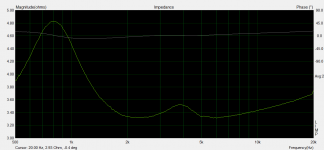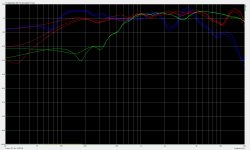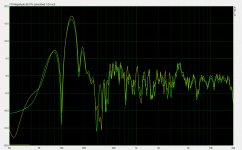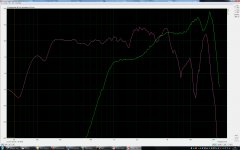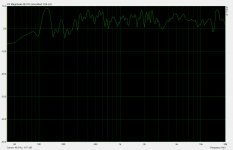When conditions are good, stepped sine is preferred. Averaging helps when you are dealing with noise, but it's also necessary for dealing with the shortcomings of reproducing and separating this band of noise.yeah I was using stepped sine, i'll go and try noise now.
.....I presume I need all 100 measurements to get a decent average?
Often, three to six averages will net the bulk of the result.
The typically available range of sensitivities tends to exceed the effect of drivers' typical nominal impedances.Would anybody agree that I would be better off purchasing another bass driver, so that I have two per side (as per the original design) in which case the impedance and hopefully output of the drivers would match more naturally?
Here's an image of the frequency sweep response of the drivers inside the cabinet, measured at 1m on axis horizontally, midway between the tweeter and mid woofer horizontally.
I'm having a lot of trouble with integrating the tweeter, the 'dip' at 3.5k is proving difficult to get rid of, as pretty much any filter network I have tried has resulted in a peak from about 4k-10k (ish)
Any suggestions on what topology you'd use? should I be considering LCR/CR pads?
I'm having a lot of trouble with integrating the tweeter, the 'dip' at 3.5k is proving difficult to get rid of, as pretty much any filter network I have tried has resulted in a peak from about 4k-10k (ish)
Any suggestions on what topology you'd use? should I be considering LCR/CR pads?
Attachments
If you have Excel, you might find Jeff Bagby's Passive Crossover Designer helpful: Loudspeaker Design Software
A very straightforward and useful tool especially when using actual measurement files. Simulate the xo as many times as you like until you finally get it the way you want it and then buy the necessary parts.
And it's free!
Playing around with the Baffle Diffraction Simulator might help as well:jbagby
A very straightforward and useful tool especially when using actual measurement files. Simulate the xo as many times as you like until you finally get it the way you want it and then buy the necessary parts.
And it's free!
Playing around with the Baffle Diffraction Simulator might help as well:jbagby
A dip at 3.5k is a pretty good problem to have, but if that's what your response looks like at 1/2 octave smoothing, I think maybe you need to revisit the measurement instructions/tips that I and another person left here for you. With a tweeter, you should have no trouble at all getting a clean graph with 1/24 smoothing. Also, you should not really be seeing any variation if you're not moving the mic (is that what the overlays indicate?). Use a few more averages if you're using the MLS signal.
Dumptruck - thanks for keeping the thread updated with advice, it's been a great help.
I'll have to re-visit the measurements procedure and work out what I'm doing wrong, the overlays were from different room positions, I was getting very ragged response curves from 1/24 smoothing so obviously doing something wrong, though I was using sine sweeps not MLS, so I'll try and sort my measurement technique out.
I tried the speaker as a 3 way with 1 or 2 bass drivers, as a 2.5 way and as a 2 way without the bass woofers.
Building the 2-way is very easy and produces a great sound, but when I add the high pass filter to the mid it seems to raise the response towards the top end, and the bass response from the woofer although good seems to be focussed around 100hz.
At this point I'm thinking i need to sort out the cabinet tuning for the bass woofer before I try to re-integrate it into a 3-way, then I expect to keep it as single bass, mid and tweeter. When I played with the crossovers yesterday (most of the day, again) I managed to achieve a flat response from 100hz to 20khz, give or take about 5db, however the overall sound was a little bit tinny/ringy (for lack of better words) I then tried rolling of the trebble a little, so the overall response curved down by about 10db between about 500hz and 15kHz. That was a lot easier to listen to, but also sounded dull and a bit life-less. My hope is when I get the bass response up to what it should be the overall sound of the speaker will be less bright, but If I fix my measurements then hopefully that'll allow me to see the cause of any audio discomfort in the trebble.
As far as crossover components go, I have a selection of parts available which I'm hoping to utilise for this project, if I can avoid purchasing more that would be good, but obviously if I can't achieve the desired results I will have to buy more!
Polymer Caps:
5.6uF, 1.8uF, 1uF (*2)
Electrolytic Caps:
2uF, 12uF, 16uF, (*4) 4.2uF, 50uF,(*2)
Inductors:
0.21, 0.32, 0.56, 0.64, 0.96, 5.6, (*2) 7.12(*4)
Resistors:
11w: 2.4ohm, 18ohm.
Not entirely sure on that last resistor value...
I'll have to re-visit the measurements procedure and work out what I'm doing wrong, the overlays were from different room positions, I was getting very ragged response curves from 1/24 smoothing so obviously doing something wrong, though I was using sine sweeps not MLS, so I'll try and sort my measurement technique out.
I tried the speaker as a 3 way with 1 or 2 bass drivers, as a 2.5 way and as a 2 way without the bass woofers.
Building the 2-way is very easy and produces a great sound, but when I add the high pass filter to the mid it seems to raise the response towards the top end, and the bass response from the woofer although good seems to be focussed around 100hz.
At this point I'm thinking i need to sort out the cabinet tuning for the bass woofer before I try to re-integrate it into a 3-way, then I expect to keep it as single bass, mid and tweeter. When I played with the crossovers yesterday (most of the day, again) I managed to achieve a flat response from 100hz to 20khz, give or take about 5db, however the overall sound was a little bit tinny/ringy (for lack of better words) I then tried rolling of the trebble a little, so the overall response curved down by about 10db between about 500hz and 15kHz. That was a lot easier to listen to, but also sounded dull and a bit life-less. My hope is when I get the bass response up to what it should be the overall sound of the speaker will be less bright, but If I fix my measurements then hopefully that'll allow me to see the cause of any audio discomfort in the trebble.
As far as crossover components go, I have a selection of parts available which I'm hoping to utilise for this project, if I can avoid purchasing more that would be good, but obviously if I can't achieve the desired results I will have to buy more!
Polymer Caps:
5.6uF, 1.8uF, 1uF (*2)
Electrolytic Caps:
2uF, 12uF, 16uF, (*4) 4.2uF, 50uF,(*2)
Inductors:
0.21, 0.32, 0.56, 0.64, 0.96, 5.6, (*2) 7.12(*4)
Resistors:
11w: 2.4ohm, 18ohm.
Not entirely sure on that last resistor value...
Ok, so I think I'm getting better measurements now, this picture shows combined MLS (avg=25) and sine sweep for the speaker in current form, this is with two bass woofers.
The extra bass woofer is obviously making the tuning (or non-tuning) of the enclosure worse, as the previous small peak above 100hz grew significantly when it was added. The enclosure is approx. .33cu/ft, with a 5cm dia 12cm port.
Any tuning suggestions would be well received, though I am trying to understand the loudspeaker cookbook better in order to improve the tuning. I thought the problem was the port was nowhere near long enough, but crude tests with longer ports don't seem to improve things at all, so maybe i need a shorter port???
I'll get FR again with a single bass woofer later.
The extra bass woofer is obviously making the tuning (or non-tuning) of the enclosure worse, as the previous small peak above 100hz grew significantly when it was added. The enclosure is approx. .33cu/ft, with a 5cm dia 12cm port.
Any tuning suggestions would be well received, though I am trying to understand the loudspeaker cookbook better in order to improve the tuning. I thought the problem was the port was nowhere near long enough, but crude tests with longer ports don't seem to improve things at all, so maybe i need a shorter port???
I'll get FR again with a single bass woofer later.
Attachments
Some people think that only first order xo's, or really high order, gives the best musical presentation. Trust your ears.One last note: I tried these at low volume levels with simple first order xo's lastnight, expecting them to sound worse, though they were arguably better, is this due to the low listening levels or something else? (I'm guessing all the advantages of using 2nd/3rd order slopes on the xo kick in at a reasonable volume)
Also, as you stated, you acheive flat response if you only use the midrange and the tweeter, but once you add the woofers, it doesnt work. Thats kinda normal. The addition of the woofers adds a whole other dimension of problems.
I think you should consider going passive for mid/tweet and going active with the woofers. This is what I did.
Its a big defi to try to make a passive three ways, but if you go half passive and half active, its a much simpler solution to have a good results. Since you already stated that you have good result with first order xo on the mid and tweet, you should keep it like that and consider going active for the bass. theirs only advantages going this way.
You shouldnt have tried to build and design a passive three-way on your first build, its way too hard for about anyone, let alone a beginner.
I think your best solution is going at least active for the bass. Add a buffer to your chains, something like the B1.
You would have two separate outputs. One going to your mid tweet and one for your bass. You add a simple high pass in the B1 buffer outputs going into your mid/tweeter. The other output would go into your bass amps. I simply bought sub amps with build in crossovers, modified the crossoover to allow me to go up to 300hz, and voila. Measure, adjust the gain and crossover, and you should have a perfectly flat response.
Pick the right drivers then use active crossovers they are far better than passive in every way other than you need three amps.
Last edited:
nanno, could you do me a favor?.
Forget the woofer for a second.
Hook up the midrange only, no capacitor in the signal path, measure really close, no smoothing.
Hook up the tweeter only, full crossover of course, measure really close, no smoothing.
Hey C.B, have done as requested, response curves attached. please ignore the levels when comparing tweeter to mid woofer, as these were changed between measurements, can't remember why now, but there was a reason.
Attachments
Guys,
Thank you for the input, if I was keeping these speakers for myself I would consider the active bass units thing, but as there original purpose no longer exists, the main aim is to learn as much as possible whilst building them then to sell and attempt to recoup at least a little of my costs, so committing more financially is being avoided where possible.
The bass response is improved now that the bass woofer is doing all the bass work, though I'm sure I can further refine the design through tweaking the port length, as the XT4 is quoted as going down to 40hz and these are dropping of rapidly from about 60, though that could be due to the lower volume and single driver of course....
I did a lot of research last night on the XT4 and found out the original crossover was in fact at single order between the tweeter and mid. Currently I'm still running 3rd order on the tweeter, but I've softened the mid pass to a single capacitor and inductor, rather than the old 3rd-order low pass that was going on. Also running an L-pad on the mid woofer now.
Current FR is attached, I'm happy with the measurements and the sound now, so have gone back to working on the cabinet. There's way more baffle vibration than I was expecting, given that the bracing is effectively a shelf from front to back between each woofer. The front baffle was 18mm, with front bracing to be added later (wait for pictures) but I've added another 18mm internally to one cabinet, I'll do the same with the other, finish them up so that I can have a quick AB of alternative xo's then it'll just be a case of controlling cabinet vibrations and finishing off... not long now
Thank you for the input, if I was keeping these speakers for myself I would consider the active bass units thing, but as there original purpose no longer exists, the main aim is to learn as much as possible whilst building them then to sell and attempt to recoup at least a little of my costs, so committing more financially is being avoided where possible.
The bass response is improved now that the bass woofer is doing all the bass work, though I'm sure I can further refine the design through tweaking the port length, as the XT4 is quoted as going down to 40hz and these are dropping of rapidly from about 60, though that could be due to the lower volume and single driver of course....
I did a lot of research last night on the XT4 and found out the original crossover was in fact at single order between the tweeter and mid. Currently I'm still running 3rd order on the tweeter, but I've softened the mid pass to a single capacitor and inductor, rather than the old 3rd-order low pass that was going on. Also running an L-pad on the mid woofer now.
Current FR is attached, I'm happy with the measurements and the sound now, so have gone back to working on the cabinet. There's way more baffle vibration than I was expecting, given that the bracing is effectively a shelf from front to back between each woofer. The front baffle was 18mm, with front bracing to be added later (wait for pictures) but I've added another 18mm internally to one cabinet, I'll do the same with the other, finish them up so that I can have a quick AB of alternative xo's then it'll just be a case of controlling cabinet vibrations and finishing off... not long now
Attachments
A shelf brace can be a good thing to reduce the cabinet's overall (first) resonance. Having them directly behind the woofers may seem logical but closer to the middle of the cabinet gives the greater effect here.
The braces may not, however help much with regards to vibrations that run through the panels.
The braces may not, however help much with regards to vibrations that run through the panels.
- Status
- This old topic is closed. If you want to reopen this topic, contact a moderator using the "Report Post" button.
- Home
- Loudspeakers
- Multi-Way
- How do you finalize/tweak your design when it's 'half built' (noob help please)
